'Bourbon street, New Orleans', 1942
(black lithograph)
(black lithograph)
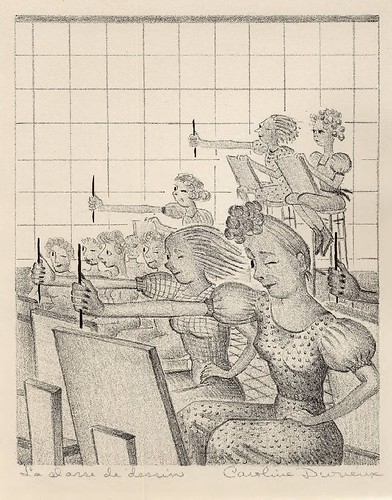
'Art class or La Classe de Dessin', 1939
(lithographic pencil and ink)
(lithographic pencil and ink)

'Dinner', 1939
(black lithograph)
(black lithograph)

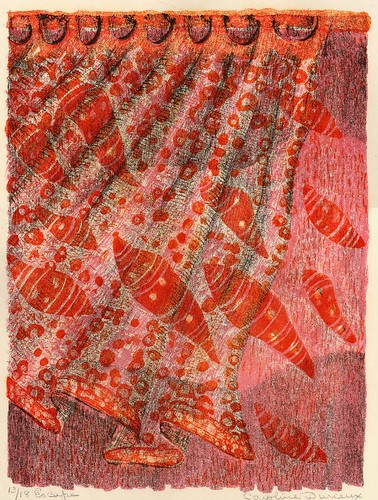
'Escape', 1962
"The subject presents an abstracted form which appears as if escaping from behind a thin veiling. The initial drawing was done by Ms. Durieux using lithographic pencil, brush and lithographic ink washes, and a minimal amount of scraping. The dots which appear within the composition were created using the lithographic gum-arabic technique. Ms. Durieux said that she has always had a number of ideas based on different means of escape and the depiction of such is to be listed among her favorite subjects. The colors used in this print are warm pink, red and black. The artist allows the white of the paper to serve as a fourth color within the composition."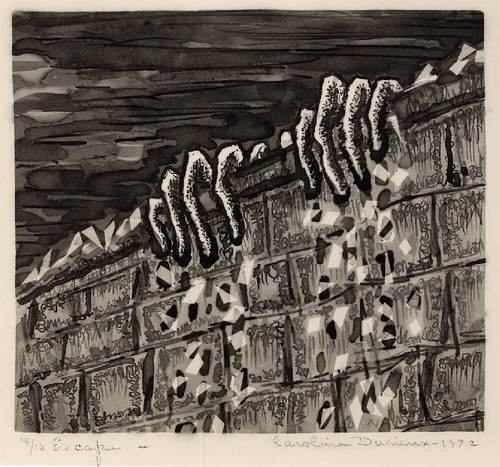
'Escape', 1972
(black and white cliché-verre)
(black and white cliché-verre)
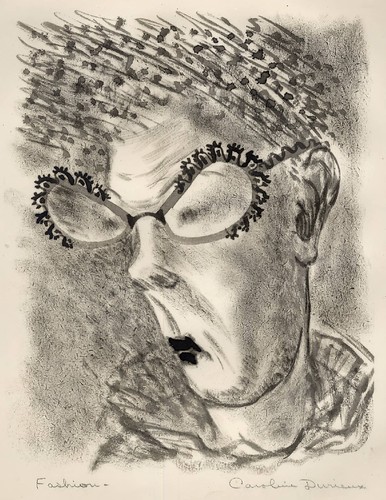
'Fashion', 1953
(black electron)
"The satire in this print is seen in the depiction of a female's face "adorned" with the exotic , fantastic, and extremely ornate eyeglasses which were in vogue in the 1950's. The satire 's comment is made in that the lady is no beauty, and the eyeglasses she thinks beautiful, only add to her unsuspected, unbecoming flamboyancy. The drawing was initially made with the radioactive ink applied with dry brush. The print presents a highly textured tonal areas due to the natural texture of the paper. The fibers of the drawing from which the print was made on sensitized paper were made radioactive and the fibers print in dark tones thus allowing this condition of the paper to work for the artist."(black electron)
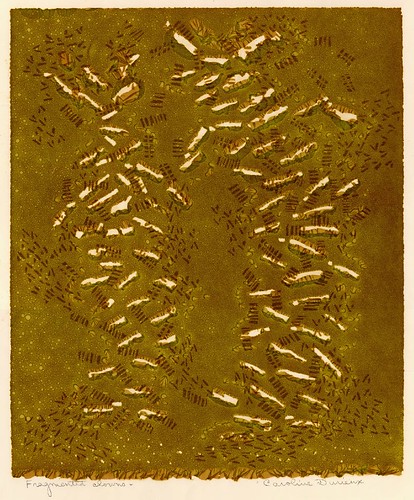
'Fragmented Clowns', 1961
(cliché-verre)
"[Ms. Durieux] always associated clowns with fragmented people"
(cliché-verre)
"[Ms. Durieux] always associated clowns with fragmented people"

'Friends of Poseiden', 1966
(cliché- verre)
(cliché- verre)

'Impasse', 1953
(black electron)
(black electron)

'On the Levee or Harding Field', 1942
(black lithograph)

'Oppression and Madness', 1942
"The print depicts two captive figures isolated within what one may consider to be a cell. A single window in the background allows for a stream of sunlight to filter into the area behind the figures, yet they take no notice of it, nor the warmth it may offer. The drawing was made using lithographic pencil, some lithographic ink and brush, and a minimal amount of scraping. The print is a general comment on the war years. Ms. Durieux was much involved with the tragedies which occurred in the Pacific and Europe. The print expresses the oppression of war as sensed by the artist."
'Persuasion', 1947
(black lithograph)
(black lithograph)

'Solace', 1974
(colour electron)
(colour electron)
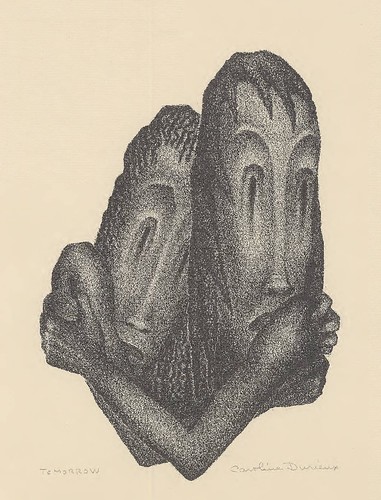
'Tomorrow', 1947
(black lithograph)

'Underwater', 1957
(colour lithograph)
(colour lithograph)
[All images © the Estate of Caroline Durieux]
"Caroline Wogan Durieux (1896-1989), a New Orleans native of Creole descent, became a celebrated Louisiana artist of the twentieth century with her work represented in the permanent collections of the Museum of Modern Art, Philadelphia Museum of Fine Arts, Smithsonian Institute, National Gallery, Library of Congress and Bibliotheque Nationale.
Durieux grew up in New Orleans on Esplanade Avenue and according to an artist's statement began graphically depicting her environment from an early age. She first studied art formally at Newcomb College under William and Ellsworth Woodward, major Southern artists painting in the regionally dominant style of Genteel Impressionism. She graduated from Newcomb with a Bachelor of Design degree (1916) and a second bachelor's degree in art education (1917). Durieux left New Orleans in 1918 to further her formal art training at the Pennsylvania Academy of Deign. She studied at the Academy until 1920; there, she gained exposure to modernist techniques and styles and established a relationship with the Philadelphia art community she would maintain throughout her art career.
In 1920, Durieux married Pierre Durieux, a New Orleanian and export businessman, and the couple moved to Cuba for his business. They relocated to Mexico in 1926 and remained there until 1936. In Mexico, Caroline Durieux developed a satirical style in her paintings and lithographs, wielding her brush at the upper class of Mexicans and American businessmen. Her work attracted the attention and praise of Mexican modernist Diego Rivera, who painted her portrait and publicly lauded her art.
Durieux returned to the United States with one-man shows in Louisiana and began to gain acclaim in her own country. In New Orleans, she became involved in a Vieux Carre art colony centered in the Arts and Crafts Club of New Orleans. She taught at the Club's New Orleans Art School and exhibited frequently at the gallery. In 1938, she assumed the directorship of the WPA Federal Art Project in New Orleans from Ellsworth Woodward. The art project created public murals and exhibited at a WPA art gallery in the Vieux Carre.
While in New Orleans, she also taught at Newcomb College between 1938 and 1943. In 1943, LSU hired her as an instructor in painting and drawing, and she moved to Baton Rouge. She received her MFA from LSU in 1949 and taught as a professor at LSU until 1963. Her research at LSU resulted in a new print-making process she named electron printing which involved radioactive ink. She also revived the nineteenth-century Barbizon School's print process of cliche verre and developed a method to add color to cliche verres.
Durieux's experiments with electron prints and her other work earned widespread acclaim, and she exhibited her work internationally throughout the century. She published two books of her lithographs, Caroline Durieux: 43 Lithographs and Caroline Durieux: Lithographs from the Thirties and Forties." [source]
- Caroline Wogan Durieux Works of Art collection includes more than two hundred lithographs, drawings, paintings and radioactive(!) prints at the Louisiana Digital Library* (click 'Browse..') {not really radioactive I don't think; more like: radiodeveloped, and Durieux dubbed the prints: 'black electrons'}
- 'Conflicted Caroline, Ridiculing the Road not Taken' IN: The Times-Picayne, March 2008.
- There are a couple of books featuring Durieux lithographs around (one, two) but I haven't seen them.
- *Many (if not all) the jpeg images in the collection are derived from djvu or MrSid file formats that sometimes detracts from the quality of the artwork. The effect is most obvious when trying to view close-up detail but they are still worth seeing for the overall composition. It did skew the choices displayed above to an extent.




















1 comment :
Well, those certainly offer endless possibilities for comment. Escape! Radioactive ink! Unbecoming eyeglasses! (I anticipate that many of today's styles will also rapidly become subjects of satire...) Fragmented clowns! Well, I've got to say that Durieux's generation of printmakers was pretty amazing but I hadn't run into many examples like these.
I quite like the art class for the purely personal reason that it amuses me as a one-time occasional art student and I can just see swarms of students clutching their pencils just like that. Though maybe in a parallel universe. One Ms. Durieux and I dreamt.
Post a Comment
Comments are all moderated so don't waste your time spamming: they will never show up.
If you include ANY links that aren't pertinent to the blog post or discussion they will be deleted and a rash will break out in your underwear.
Also: please play the ball and not the person.
Note: only a member of this blog may post a comment.